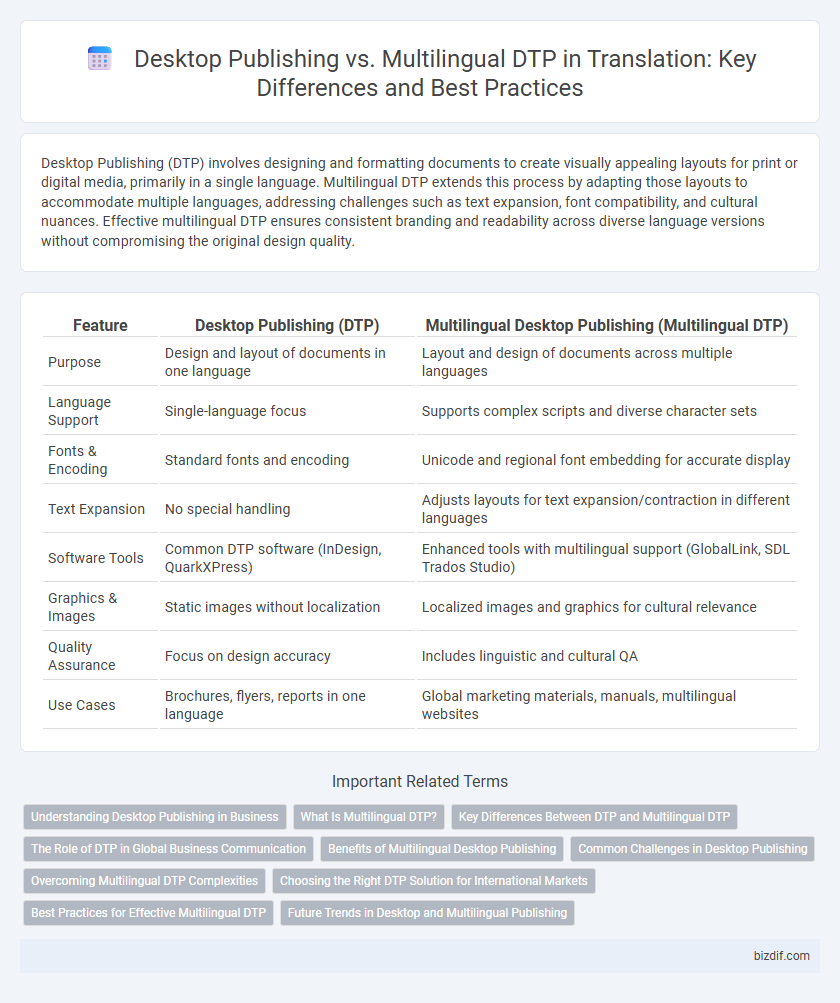Desktop Publishing (DTP) involves designing and formatting documents to create visually appealing layouts for print or digital media, primarily in a single language. Multilingual DTP extends this process by adapting those layouts to accommodate multiple languages, addressing challenges such as text expansion, font compatibility, and cultural nuances. Effective multilingual DTP ensures consistent branding and readability across diverse language versions without compromising the original design quality.
Table of Comparison
| Feature | Desktop Publishing (DTP) | Multilingual Desktop Publishing (Multilingual DTP) |
|---|---|---|
| Purpose | Design and layout of documents in one language | Layout and design of documents across multiple languages |
| Language Support | Single-language focus | Supports complex scripts and diverse character sets |
| Fonts & Encoding | Standard fonts and encoding | Unicode and regional font embedding for accurate display |
| Text Expansion | No special handling | Adjusts layouts for text expansion/contraction in different languages |
| Software Tools | Common DTP software (InDesign, QuarkXPress) | Enhanced tools with multilingual support (GlobalLink, SDL Trados Studio) |
| Graphics & Images | Static images without localization | Localized images and graphics for cultural relevance |
| Quality Assurance | Focus on design accuracy | Includes linguistic and cultural QA |
| Use Cases | Brochures, flyers, reports in one language | Global marketing materials, manuals, multilingual websites |
Understanding Desktop Publishing in Business
Desktop Publishing in business involves creating visually appealing documents by combining text and graphics using software like Adobe InDesign or QuarkXPress. It ensures brand consistency and professional layout, essential for marketing materials, brochures, and reports. Multilingual DTP extends this process by adapting these documents for different languages and cultures, maintaining design integrity while addressing localization needs.
What Is Multilingual DTP?
Multilingual Desktop Publishing (DTP) involves the process of designing and formatting documents that support multiple languages and scripts, ensuring accurate text flow, font compatibility, and cultural adaptation. It integrates language-specific typographic rules and localized graphics to create visually consistent and professional multilingual materials. Multilingual DTP is essential for global businesses seeking seamless communication across diverse markets with precise layout and linguistic accuracy.
Key Differences Between DTP and Multilingual DTP
Desktop Publishing (DTP) primarily involves designing and formatting documents in a single language, focusing on layout, typography, and visual elements. Multilingual DTP extends these tasks by incorporating language-specific typographic rules, text expansion or contraction adjustments, and cultural nuances to ensure accurate and visually appealing localized content. Key differences include handling multiple character sets, adapting design elements for various languages, and ensuring right-to-left or vertical text support where necessary.
The Role of DTP in Global Business Communication
Desktop Publishing (DTP) in global business communication ensures the precise layout and design of multilingual content, maintaining brand consistency across diverse markets. Multilingual DTP integrates language-specific typographic rules and cultural nuances to enhance readability and engagement for international audiences. Effective DTP streamlines global marketing efforts by producing visually appealing, accurately localized materials that support cross-cultural communication and brand recognition.
Benefits of Multilingual Desktop Publishing
Multilingual desktop publishing enhances global communication by ensuring culturally accurate and linguistically precise document layouts tailored to diverse language requirements. It streamlines the localization process, reduces errors in font rendering, text expansion, and bidirectional text handling, leading to higher-quality translated materials. This approach optimizes workflow efficiency, supports multiple scripts and complex typographies, and ultimately improves brand consistency across international markets.
Common Challenges in Desktop Publishing
Desktop publishing often faces challenges such as font compatibility, text expansion, and layout disruption, which become more complex in multilingual DTP due to diverse scripts and language directions. Handling bidirectional text, maintaining consistent formatting across languages, and managing localized graphics are critical hurdles in multilingual desktop publishing workflows. Effective collaboration between translators and DTP specialists is essential to ensure accurate text rendering and visual coherence in multilingual projects.
Overcoming Multilingual DTP Complexities
Overcoming multilingual DTP complexities involves managing diverse character sets, right-to-left scripts, and variable text expansion in different languages to ensure accurate layout and formatting. Specialized software and experienced linguists collaborate to maintain the visual integrity of documents across languages while addressing font compatibility and Unicode standards. Efficient multilingual desktop publishing streamlines global content delivery by integrating translation workflows with advanced typographic controls and localization tools.
Choosing the Right DTP Solution for International Markets
Selecting the right desktop publishing (DTP) solution for international markets requires understanding the distinction between standard desktop publishing and multilingual DTP. Multilingual DTP supports complex scripts, bidirectional text, and font embedding for diverse languages such as Arabic, Chinese, and Hindi, ensuring accurate layout and typography across cultures. Investing in specialized multilingual DTP software enhances global brand consistency, reduces localization errors, and streamlines workflows for international content publishing.
Best Practices for Effective Multilingual DTP
Effective multilingual desktop publishing (DTP) requires the integration of language-specific typography, proper font selection, and text expansion allowances to maintain design consistency across diverse languages. Utilizing translation memory tools and localization-ready software enhances accuracy and streamlines workflows by minimizing manual adjustments. Collaboration between translators, designers, and project managers ensures cultural relevance while preserving the visual integrity of the final product.
Future Trends in Desktop and Multilingual Publishing
Future trends in desktop publishing emphasize seamless integration with AI-driven design tools, enabling automated layout adjustments and enhanced content personalization. Multilingual DTP is evolving through advanced machine translation coupled with adaptive typesetting, ensuring culturally accurate and visually consistent outputs across diverse languages. Cloud-based collaboration platforms are becoming standard, facilitating real-time multi-language editing and streamlined workflows for global publishing teams.
Desktop Publishing vs Multilingual DTP Infographic

 bizdif.com
bizdif.com